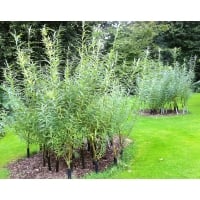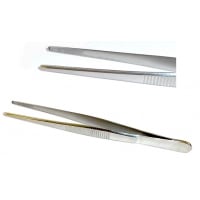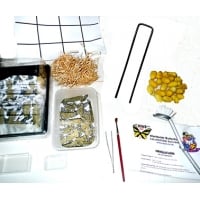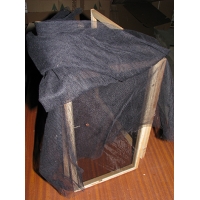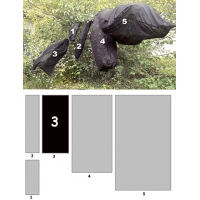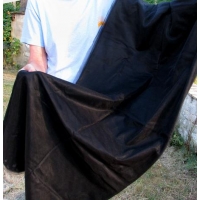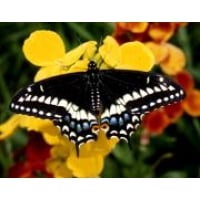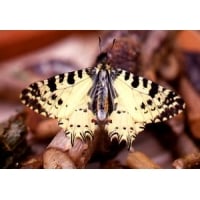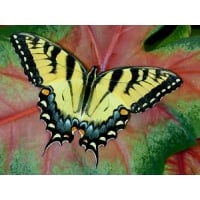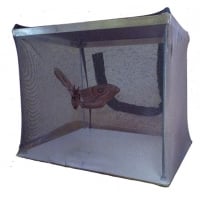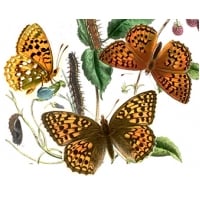MARKET STALL Everything a BARGAIN!
Small numbers only. First come first served!
Pure Silk hanks These are English reeled 20/22 Denier raw silk hanks produced at the Lullingstone Silk Farm and Worldwide Butterflies.
These fine silk hanks were reeled on the same hand reeling machine, the only one in
The size and weight not standard but the illustration shows a hank picked at random. This is a unique product!
Special temporary promotion price.
Osier Willow cuttings S. viminalis
Years ago we planted a stick that was floating down a river in Wiltshire. That was in 1954! It grew – rapidly – producing a wealth of leaves. We tried it as a foodplant and discovered that not only did British species do well on it, but exotic silkmoth larvae as well.
This stick was the daddy of hosts of willow thickets that we have established in Dorset, Cornwall and in France.
Osier is Basket Willow, the flexible essential for basket weaving. It makes a wonderful woven hedge. It can form living sculptures. Winter or summer, Osier makes wonderful screens and windbreaks. Cover for wildlife and game. Osier is grown as a crop for energy production. In short it is a blessing to the environment, and very pleasant on the eye in landscaping schemes.
We are offering a bunch of 10 cuttings for you to try not only as probably the most universal foodplant for larvae, but a great addition to your garden and grounds.
Probably the easiest cuttings to strike and grow. You simply push them into the ground, during autumn or spring. Leaves will appear within the first fortnight if planted in spring, roots quickly follow. In the first year they will more than double in size. Next year, in normal drought free conditions, if you winter prune very hard, you will have perhaps 2 metres of growth on every branch, providing masses of foodplant. You may even be able to feed some in the first year.
You can store cuttings before planting, either in a polythene bag in the fridge, or standing in water. In water they often start to root. It is advisable to plant them before the roots actually burst out of the bark.
This plant is a complete success story – you will be pleased you tried it!
New Design LARVAE FORCEPS
High quality stainless steel. Ideal for moving leaf particles and stems with larvae attached, while changing rearing boxes. These are new to the WWB range. They have a smooth and positive feel, and an excellent grip.
THE MINI SILK FARM
A complete outfit for rearing silkworms from egg to cocoon, and reeling your own raw silk. Everything is provided: a small batch of eggs, food for the entire life of 20 silkworms, all the rearing equipment, detailed educational documentation and instructions, and a simple reeling device.
There is even a small bag of cocoons so that you can practise reeling, and don't have to wait to rear the cocoons from the egg.

Normally Silkworms feed on Mulberry leaves. This is an uncommon tree that is not always readily available, so we are providing a substitute food, which is a powder that comes with the necessary instructions for preparing the artificial diet in the kitchen. You will have a supply of fresh food always available for the silkworms throughout their life of about a month.
The Mini Silk Farm can be bought at any time of the year. The eggs are stored in a fridge until incubation. Although rearing in summer is easier because of temperature, you can rear silkworms almost throughout the year, if you can keep them at about 25º-28ºC. Eggs supplied in winter will need to be refrigerated for 8-12 weeks before incubation.
The instructions guide you through easy rearing, preparation of the artificial diet and the reeling process. The Mini Silk Farm is fun and unusually educational.
NETTING Fine black/grey Nylon 10 metres 150cm wide
If you are thinking of making a netting structure, cage covering and replacement or making sleeves for rearing larvae, this is the ideal netting.
Durable, resists tearing and deterioration in UV light. It is fine enough to keep out all but the minutest flies and parasites.
NEW Zipped Bag Sleeve with side opening for instant access.
This size is ideal for rearing to pupation about ten larvae, or for keeping larger numbers of younger larvae. The end of the bag is sewn closed. The open end is slipped over a branch and tied or fastened with velcro strip.
The side zip gives wide access for inspection, photography or removal of frass and any dead leaves. Also ideal when you find that a caterpillar has hitched a lift on your arm! When you use a Zipped Bag Sleeve you will wonder why it has taken until now to use such an innovation!
NETTING Fine black/grey Nylon 20 metres (2 x 10m) 150cm wide.
Ideal for large structures, flight areas etc.
Use for cage covering or making sleeves for rearing larvae.
Durable, resists tearing and deterioration in UV light. It is fine enough to keep out all but the minutest flies and parasites.
Ordering in 20 metre lots brings the price down very low! 170cm wide.
Black Swallowtail Papilio polyxenes asterias North America
Very closely related to the European and British swallowtails, asterias will often hybridise with either, producing interesting offspring.
The collections of 4 pupae comprise 3 male and a female pupa for breeding.
The larvae feed on Fennel, Carrot tops, and some other Umbelliferae including wild and probably cultivated Parsnip. Two broods are produced in the year and the pupae of the second brood hibernate.
Eastern Festoon Allancastria cerisyi
Found in Eastern Europe into Asia Minor. This group finds itself between the Apollos and Swallowtails. The larvae feed on local Aristolochia species and will normally take Birthwort A. clematitis.
Becoming harder to obtain, these pupae overwinter in a cold place and will emerge usually in May when brought out to emerge.
Tiger Swallowtail Papilio glaucus North America
The Tiger Swallowtail is perhaps North America’s grandest swallowtail. As a curiosity, a small proportion of females emerge as melanics, not as beautiful as the typical female, but different! They can be bred in captivity and the larvae are as exotic as many of the tropical swallowtails, with the Papilio eye markings and bird dropping camouflage in the early instars.
Try feeding them on Cherry, Ash or Lime, and they will probably take a wider variety of foodplants.
Pyjama Mini Cage 22 x 29 x 25cm high
This popular cage has just got even better. Nearly a third larger, and much improved dimensions.
Ideal as a beginner's cage, but also for the busy breeder who wants separate small cages. Excellent as an emerging cage for chrysalides and cocoons, ideal for keeping small numbers of larvae or other insects, when large enough for cage rearing.
This cage is suitable for laying out small numbers of pupae to emerge. Also for rearing smaller numbers of larvae or smaller larvae. Baby larvae should be first reared in plastic rearing containers or kept covered on growing food. Please see the note on the page for plastic rearing containers. This cage will hold small covered pots of plant, and larger sizes of cage are available for larger subjects.
When necessary the netting cover can be slipped off for cleaning or replacement. The Pyjama Mini cage is assembled in minutes and easily packed flat for winter storage. As the interest grows there are larger sizes available. For the experienced breeder the Mini Cage has many uses where a series of smaller cages is needed for separating species and giving different treatment.
The cover can be washed by hand or machine, making your used cage like new for almost no effort, and no cost.
Dark Green Fritillary Mesoacidalia aglaia
Best reared on potted Violet. These larvae are in hibernation. Keep the larvae in winter out of doors, in all weathers, protected amongst dead bramble and other leaves, amongst growing Violet. Cover with netting sleeve to exclude predators and to prevent escape.


